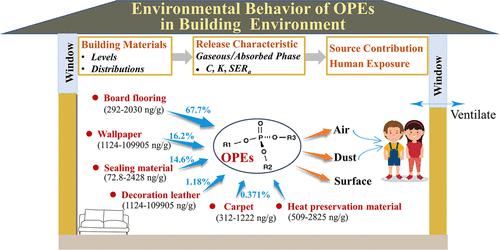当前位置:
X-MOL 学术
›
Environ. Sci. Technol.
›
论文详情
Our official English website, www.x-mol.net, welcomes your
feedback! (Note: you will need to create a separate account there.)
Organophosphate Esters in Building Materials from China: Levels, Sources, Emissions, and Preliminary Assessment of Human Exposure
Environmental Science & Technology ( IF 10.8 ) Pub Date : 2024-01-24 , DOI: 10.1021/acs.est.3c08432
Xu Han 1 , Wenhui Li 1 , Yanjun Zhao 1 , Yuan Zhuang 1 , Qi Jia 2 , Hongyan Guan 2 , Jiemin Liu 1, 3 , Chuandong Wu 1
Environmental Science & Technology ( IF 10.8 ) Pub Date : 2024-01-24 , DOI: 10.1021/acs.est.3c08432
Xu Han 1 , Wenhui Li 1 , Yanjun Zhao 1 , Yuan Zhuang 1 , Qi Jia 2 , Hongyan Guan 2 , Jiemin Liu 1, 3 , Chuandong Wu 1
Affiliation

|
Source characteristics and health risks of indoor organophosphate esters (OPEs) are limited by the lack of knowledge on emission processes. This study attempted to integrate the contents and emissions of OPEs from indoor building materials to assess human health effects. Thirteen OPEs were investigated in 80 pieces of six categories of building materials. OPEs are ubiquitous in the building materials and ∑13OPE contents varied significantly (p < 0.05) from 72.8 ng/g (seam agent) to 109,900 ng/g (wallpaper). Emission characteristics of OPEs from the building materials were examined based on a microchamber method. Depending on the sample category, the observed initial area-specific emission rates of ∑13OPEs varied from 154 ng/m2/h (carpet) to 2760 ng/m2/h (wooden floorboard). Moreover, the emission rate model was developed to predict the release levels of individual OPEs, quantify source contributions, and assess associated exposure risks. Source apportionments of indoor OPEs exhibited heterogeneities in multiple environmental media. The joint OPE contribution of wallpaper and wooden floorboard to indoor dust was up to 94.8%, while latex paint and wooden floorboard were the main OPE contributors to indoor air (54.2%) and surface (76.1%), respectively. Risk assessment showed that the carcinogenic risks of tris(2-chloroethyl) phosphate (3.35 × 10–7) were close to the acceptable level (1 × 10–6) and deserved special attention.
更新日期:2024-01-24







































 京公网安备 11010802027423号
京公网安备 11010802027423号